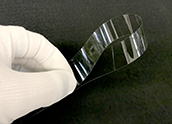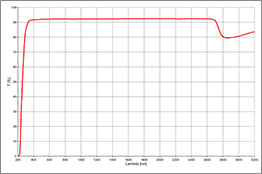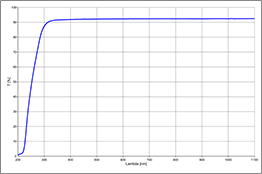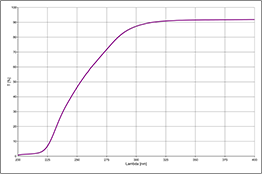AS 87 eco – Ultra-thin aluminosilicate glass
Special Properties
- Ultra-thin standard thicknesses
- Very low micro-roughness
(typically ≤ 0.5 nm / RFA-measurement) - High UVB transmissivity
- Excellent infrared transmission
- Low total thickness variation (TTV)
- Suited for chemical strengthening
- Very high impact resistance and mechanical strength
(only after chemical strengthening)
Typical Applications
- Cover glass for sensor optics
- Displays for smartphones
- Fingerprint sensors
- Flexible optics
- Thin glass spacers
- Specialty cover glasses for research and science
- Micro-optics
Related glass materials
- D 263 T
(ultra-thin borosilicate display glass from SCHOTT) - AF 32® eco
(alkali-free alumina-borosilicate glass from SCHOTT) - MEMpax®
(thin borosilicate glass from SCHOTT) - 0211
(alkali-reduced borosilicate thin glass from CORNING) - Selected float glass
(Mirror-grade iron-reduced soda-lime-thin glass)
Request for Quotation
![]() Available in 48-hour express service
Available in 48-hour express service
The high-quality ultra-thin aluminosilicate glass AS 87 eco from SCHOTT is available in a thickness range of 50–350 μm with very tight thickness tolerances.
The UVB-transmissivity of AS 87 eco is higher than that of most other ultra-thin glass materials. At a thickness of 175 μm, the transmission typically reaches about 80% at 290 nm. Even at 250 nm, AS 87 eco still transmits about 40% of light. The UV transmission is not as high as that of quartz glass. However, as producing such ultra-thin quartz glass parts requires great effort at a high cost, AS 87 eco aluminosilicate glass can often be a cost-effective alternative solution if no deeper UV transmission is required.
AS 87 eco glass also offers excellent optical permeability in the infrared range. At 175 μm glass thickness and wavelengths from approx. 350 to 2700 nm, the material lets pass more than 90% of IR light.
 |
Even fragile, non-strengthened, ultra-thin AS87 eco glass at 50 µm thickness is flexible within certain limits and thinner than a sheet of paper. |
AS 87 eco at 50 μm thickness, not chemically strengthened.
The front glasses of fingerprint sensors are often made of AS 87 eco glass. It is also ideal for manufacturing components like ultra-thin sensor covers, optical semiconductors, glass covers for research and science, or glass spacers. Also, it is part of many smartphone displays.
All AS 87 eco-materials allow chemical strengthening by ion exchange for applications with high mechanical strength requirements. This process gives the ultra-thin glass drastically increased bending, scratch, and impact resistance. Please send us a separate inquiry for a chemically strengthened AS 87 eco thin glass version. Unless stated separately, all data in this spec sheet refers to the non-strengthened glass products. The "eco" in the glass name means that SCHOTT only uses environment-friendly refining agents for the AS 87 glass production.
Some years ago, our company developed a unique CNC-cutting system and the necessary technologies to process ultra-thin glass thicknesses. These technologies enable us to process and deliver even ultra-thin glass within our 48-hour express service.
To request a quotation for ultra-thin AS 87 eco glass with your required dimensions, please choose a thickness from the table in the specifications or click the following button.
Specifications
Optical transmission at 175 µm glass thickness
AS 87 eco transmission at 200–3200 nm

View transmittance curve at 200–3200 nm
AS 87 eco transmission at 200–1100 nm

View transmittance curve at 200–1100 nm
AS 87 eco UV-transmission at 200–400 nm

View UV-transmittance curve at 200–400 nm
Standard Thicknesses
(Please click on a glass thickness to request a quote)Thickness |
Tolerance |
|
|---|---|---|
| 50 µm | ± 5 µm | ✔ |
| 100 µm | ± 15 µm | ✔ |
| 175 µm | ± 15 µm | ✔ |
| The thicknesses marked with "✔" are also available within 48–h Express Service. | ||
| The following additional thicknesses of AS87 eco glass are available on special request: 70, 145, 210, 250, 300, and 350 µm. Please send us your inquiry in case of the need for one of these thicknesses. | ||
Optical Properties
- Abbe number: ve = 59.5
- Photo-elastic constant 29.0 (nm/cm)/MPa
Refractive index chart |
||
|---|---|---|
Designation |
Wavelength (nm) |
Refractive Index |
ng |
436 |
1.5225 |
nF' |
480 |
1.5104 |
nF |
486 |
1.5099 |
ne |
546 |
1.5061 |
nd |
587.5 |
1.5041 |
nD |
589.3 |
1.5040 (±0.0015) |
nC' |
644 |
1.5019 |
nC |
656 |
1.5015 |
Mechanical Properties
- Density: 2.46 g/cm3
- Young's modulus E: 73.3 kN/mm2
- Poisson's ratio μ: 0.216
- Torsion modulus G: 30.1 kN/mm2
- Knoop hardness (HK 0.1/20):
- 500 (not strengthened)
- 560 (chemically strengthened)
- Vickers hardness (HV 0.2/25):
- 550 (not strengthened)
- 630 (chemically strengthened)
Thermal Properties
- Coefficient of thermal expansion (CTE):
8.7 × 10-6/K (20 °C ; 300 °C)
- Viscosities:
- Softening Point (107.6 dPa): 872 °C
- Annealing Point (1013 dPa): 633 °C
- Strain Point (1014.5 dPa): 594 °C
- Transformation temperature Tg: 621 °C
- Mean specific heat capacity (20–100 °C):
0.84 J/(g × K)
Chemical Properties
- Hydrolytic resistance class: HGB 2
- Acid resistance class: S4
- Alkali resistance class: A1
Electrical Properties
Dielectric Constant (permittivity) εr |
||||||
|---|---|---|---|---|---|---|
| Frequency in GHz | 0.001 |
1.0 |
2.0 |
5.0 |
24 |
77 |
7.7 |
7.3 |
7.3 |
7.2 |
7.2 |
7.1 |
|
Loss Tangent tan(δ) x 10-4 |
||||||
|---|---|---|---|---|---|---|
| Frequency in GHz | 0.001 |
1.0 |
2.0 |
5.0 |
24 |
77 |
138 |
133 |
148 |
172 |
330 |
380 |
|
- Conductivity (S/cm ; DC ; 25 °C): 5.6 × 10-12
You can find more ultra-thin glasses here:
- D 263 T (ultra-thin display glass from SCHOTT)
- AF 32® eco (alkali-free thin glass from SCHOTT)
- 0211 (display thin glass from CORNING)
- MEMpax® (borosilicate thin glass from SCHOTT)
If you are searching for further technical information, please contact us.
All data and specifications given are average guide values and are not guaranteed. Moreover, please consider the “Notes on Specifications”.© 1994 – 2025 Präzisions Glas & Optik GmbH
Last update: November 27, 2024


